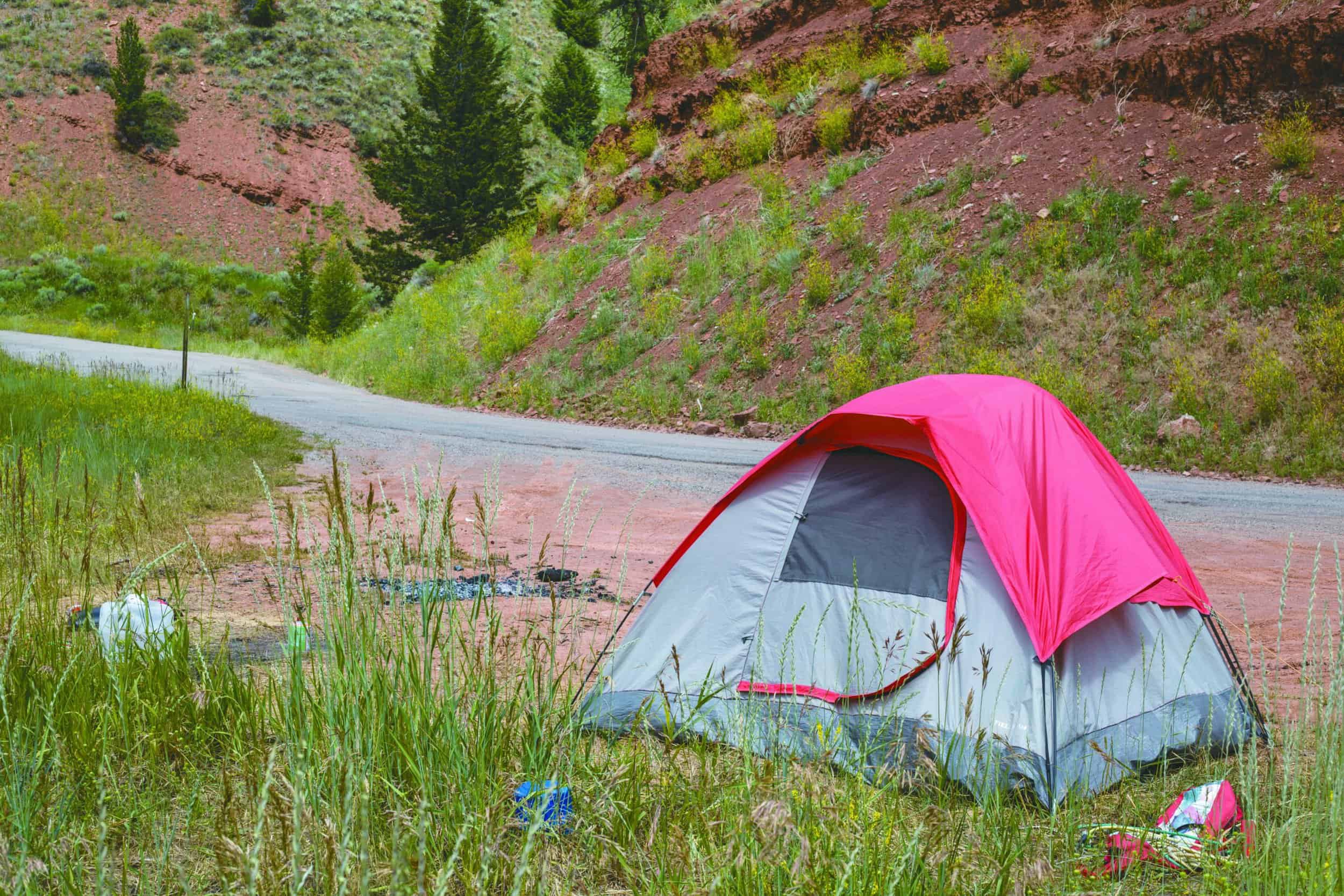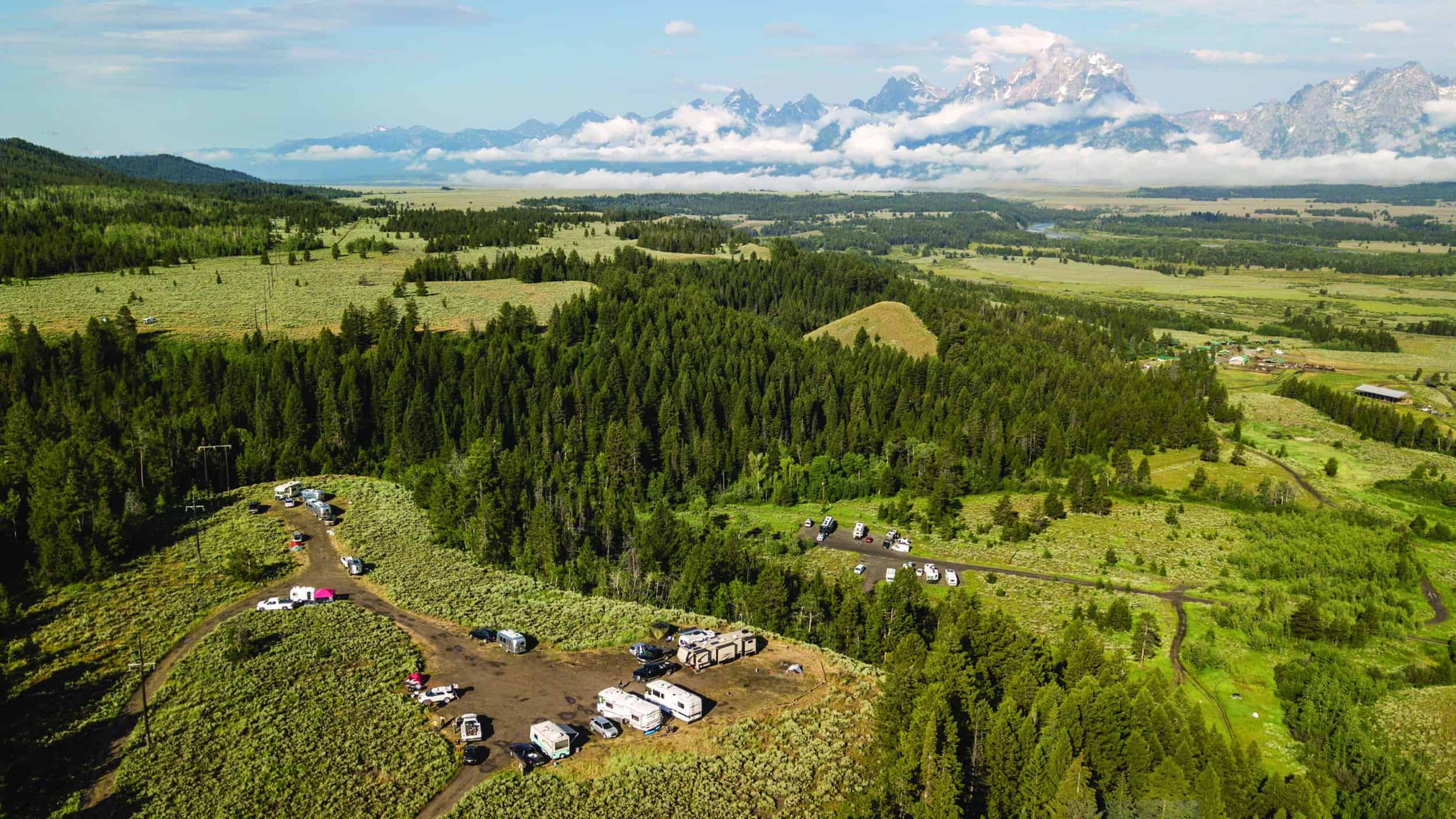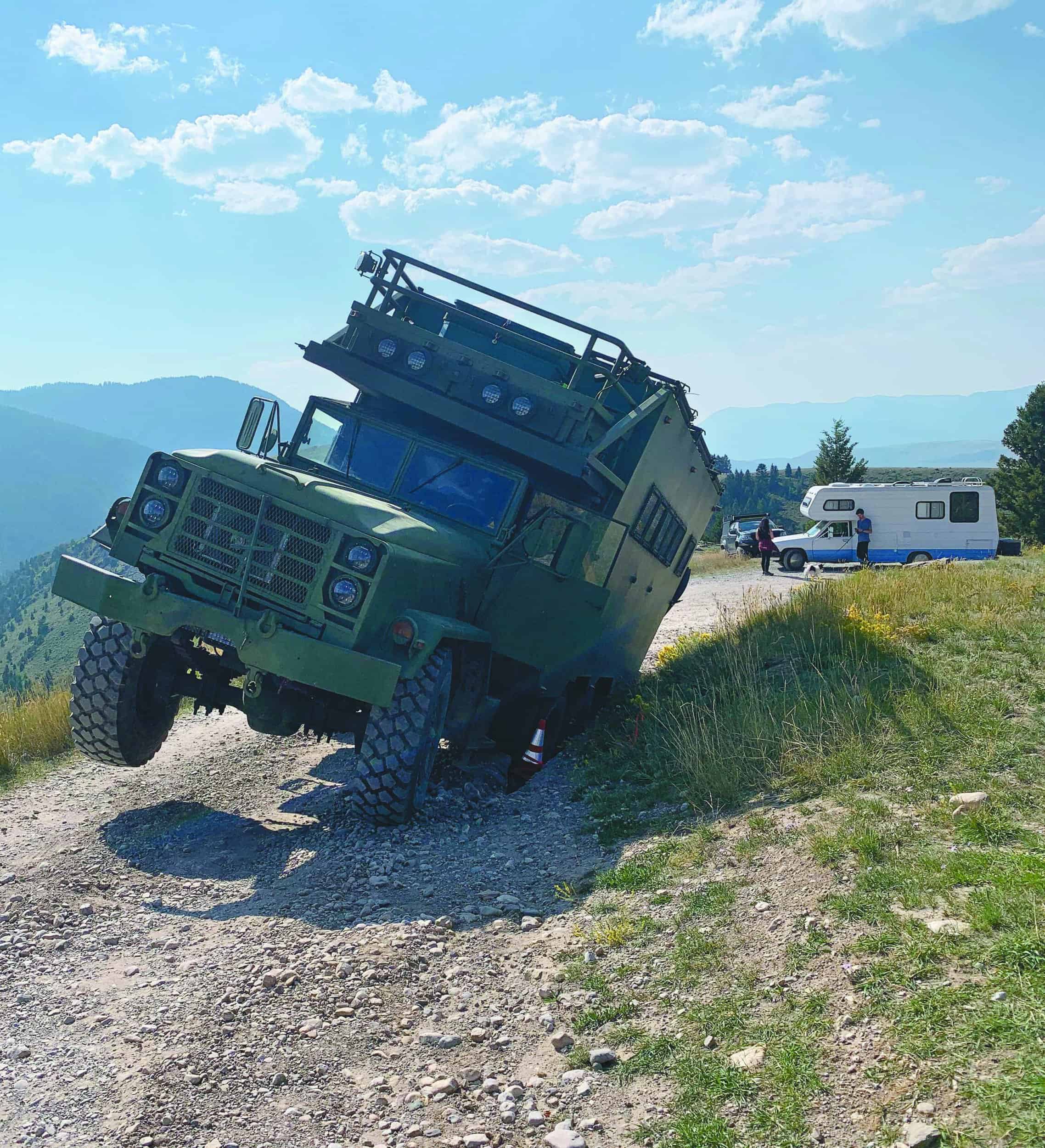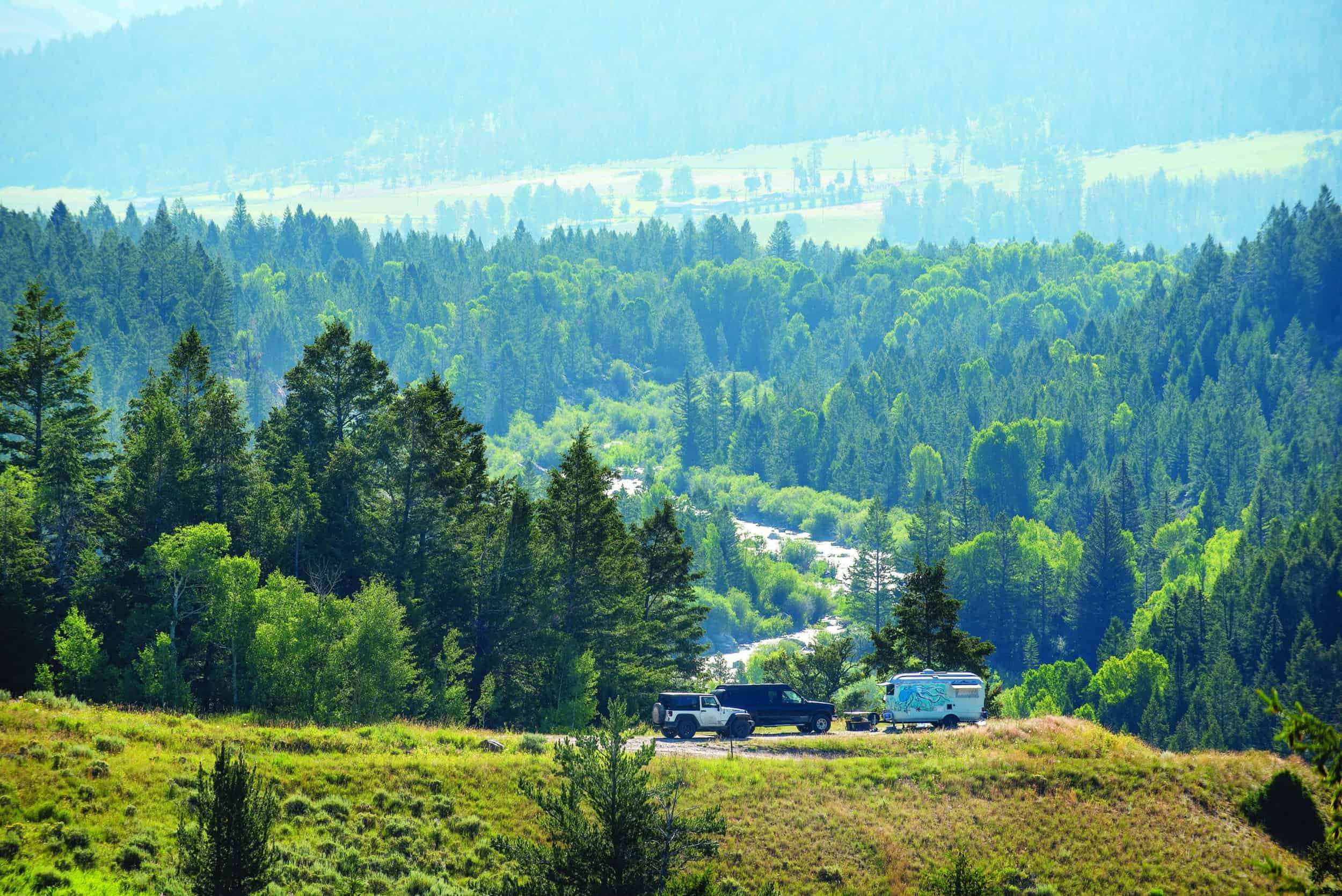Read The
Current Issue
When Did Camping Get So Hard?
More people discovering the joys of car camping means campsites are getting harder and harder to come by.
// By Molly Absolon

You can’t get much better than sitting in front of your camper van staring off at the Teton Range as the sun sinks and the mountains turn pink. “We were stoked to finally see the Teton Range in person,” wrote Brie Goumaz on her blog about vanlife, Chasing the Wild Goose. “They are just as majestic as described and more breathtaking than I could have ever imagined. They sit towering over you with snowcapped peaks so tall you’re not sure if it’s truly the peak or if the clouds are covering up just how high they really are. Add in the crisp fresh air and miles of room to roam free and uninhibited for a wondrous vanlife in Jackson experience.”
Wondrous as such experiences are, it isn’t a surprise they’re growing in popularity. This growth has brought pressure on the car-camping scene around Jackson Hole for locals and visitors alike.
“All of the usual spots are gone,” says Larry Hartenstein, who has enjoyed car-camping adventures in the area since moving here in 2000. “It used to be that you could head out on Friday after work and get something at Shadow Mountain, or up Curtis Canyon, or in Granite Creek, but do that now, and you’re not getting anything. Now I’ll go midweek and get up early and go directly to work.”
Ten years ago, Michelle Escudero’s family used to make the 2.5-hour drive to Jackson from their home in Lander at least once a month in the summer. Escudero’s daughter went to a Teton Science Schools summer camp, while Escudero and her husband would catch a Grand Teton Music Festival performance and hike in Grand Teton National Park. Often, they’d go out for a nice meal in town before heading out to Shadow Mountain to camp. It was a relaxing, fun way to take advantage of the “big city” amenities of Jackson while still getting outside in nature. But not anymore. “Jackson is such a pain to find camping that it really isn’t worth the stress,” Escudero says. Not exactly the sentiments shared on vanlife blogs or #vanlife Instagram posts.
“We’ve had people come to us in tears,” says Linda Merigliano, the wilderness and recreation program manager for the Bridger-Teton National Forest, which manages a total of 400 campsites in the Jackson Ranger District. These sites can be found in 12 developed campgrounds, in designated dispersed-camping areas (like Shadow Mountain, Curtis Canyon, Pacific Creek, Phillips Ridge, Toppings Lake, and Spread Creek), as well as in unregulated dispersed-camping sites along Fall Creek Road, Slate Creek in the Upper Gros Ventre, and Buffalo Valley. “They just want to find someplace to spend the night. We are bursting at the seams. The increase is pretty phenomenal. Some campgrounds were at 173 percent occupancy for [last] season. Our campground concessionaires are doing their darnedest to accommodate people by putting in temporary campsites in parking areas, really anything they can do to increase the number of sites available to people.” Hartenstein says, “I’ve definitely shared some camp spots over the past few years. It was late and we were out of options, so we asked people already at sites if they’d be OK if we shared their site. We’ve shared sites with some real fun people and had some people say ‘no’ as well, and I get it. Sometimes you’re camping to get away from people.”
In Grand Teton National Park, where five campgrounds and one RV park together offer more than 1,000 sites, the increase is less dramatic. This is partially because none of these sites are free, but mostly because there is no room for increased use; it’s been decades since you’ve been able to drive into the park’s Jenny Lake or Gros Ventre Campground after lunch and not find all of the spots already occupied.

This boom in outdoor recreation and public land visitation is not limited to Jackson Hole. According to the Outdoor Foundation’s 2021 Outdoor Participation Trends Report, in 2020, 7.1 million more Americans participated in some form of outdoor recreation than in 2019 (for a total of about 200 million Americans doing something outdoors). Fifty-three percent of Americans ages six and over participated in outdoor recreation at least once in 2020, which is the highest participation rate on record. While these numbers do not speak to car camping itself, they coincide with a spike in the sales of recreational vehicles, from traditional RVs to fifth wheels, campers, or a van like the Mercedes Benz Sprinter. In 2021, approximately 576,065 of these were sold, more than 140,000 more than in 2020. (And 2020 sales were 6 percent higher than 2019’s, despite a nearly two-month shutdown due to Covid in that year.)
While many of these vehicles are used recreationally, the U.S. Census Bureau estimated in 2019 that more than 140,000 people were living full-time in vans or recreational vehicles; this is a 38 percent increase from three years before. According to thewanderingrv.com, about 1 million people are living in recreational vehicles in 2022.
The BTNF’s campground data shows a 44 percent increase in the number of people and a 58 percent increase in average campsite occupancy between 2016 and 2020.
Dave Anderson, a guide, writer, and photographer who lived in his van, Magic, with his wife for five years before settling in Las Vegas, says vanlife was appealing because it offered the ability to roam. “The biggest thing we love about Magic is the freedom to work wherever we happen to be parked, live comfortably, and pursue our passion of climbing,” he told Adventure Journal. Anderson is not alone. A recent Google search for “vanlife” yielded 18 million results, and there are more than 12 million Instagram posts tagged #vanlife.
The BTNF’s campground data shows a 44 percent increase in the number of people and a 58 percent increase in average campsite occupancy between 2016 and 2020. The data is less robust for its dispersed-camping areas (see sidebar for definition), but monitoring records maintained by onsite ambassadors indicate that the designated dispersed sites at Shadow Mountain, Toppings, and Curtis Canyon were usually full early in the day during the core summer months. “There has been a seismic shift in the volume of people we are seeing utilizing the forest,” says Scott Kosiba, the executive director of Friends of the Bridger-Teton National Forest, a nonprofit that supports the BTNF. “People are drawn here by the parks, and it never occurs to them that they might have to plan ahead. We get a lot of people arriving here at 7 p.m. expecting to find a campsite. We are trying to get the message on how to recreate responsibly out, but how do you reach people who are not already seeking that information? How do you get to people when you don’t have entrance gates? Our ambassadors are our last line of defense before someone burns the forest down or leaves out food and attracts a grizzly bear.”

Kosiba says he’s seen a change in the type of camper looking for a site in the BTNF. There’s more diversity in experience—specifically more people who are new to car camping and don’t yet know how to minimize their impact on the land and other users. Last year, visitors in a 30-foot converted military vehicle tried to drive to the BTNF’s Curtis Canyon Campground. On the road to the campground, the driver passed a sign stating the road was not appropriate for rigs of that length. The campers never made it to the campground; they got stuck when their vehicle fell off the side of the road, which switchbacks up a steep hillside. Merigliano says the rescue effort was involved and dangerous, and indicative of the challenges she, her staff, and the volunteer ambassadors who patrol the BTNF to educate visitors, face as they try to mitigate the impacts of increased visitation.
Merigliano says that last summer, the BTNF used three metrics to determine if the season was a success: “We couldn’t have an escaped campfire. We couldn’t have a habituated bear, and everyone had to survive the season. And we achieved that. I’m really proud of everyone pulling together.” Based on these three things, which many land managers would agree are pretty basic, the BTNF’s summer last year was successful. But BTNF employees and ambassadors still extinguished 44 hot campfires, cleaned 686 fire rings, and issued 150 designated-site-requirement violations and 103 food-storage violations.
“It’s a challenge,” Merigliano says. “We’re constantly trying to adjust. There’s a lot more pressure on staff, and we’ve got to ramp up enforcement capabilities. Also there needs to be more conversations happening in the community,” she says. “We need everyone to be an ambassador. If you hear someone is coming to Jackson, ask them if they have a plan. If you see something that looks weird, call us and let us know.”
In an attempt to handle the crowds and limit the impact, the BTNF and GTNP have made changes in their camping policies. Last summer GTNP implemented a reservation-only system for all campgrounds in the park through the website recreation.gov.
According to GTNP public information officer CJ Adams,
this change was a success. “If you look back at the
summer of 2019, we had long lines at the campgrounds,” Adams says. “People were showing up early in the morning, hoping to get a site when someone left. That resulted in a lot of traffic congestion. The reservation system improves the visitor experience by streamlining the camping process and giving visitors the ability to plan ahead.”
Plan ahead is right. Sites in GTNP can be reserved up to six months in advance. A quick scan of recreaton.gov in February showed the park’s Jenny Lake campground, which has 51 drive-to, tent-only sites and 10 sites for walk-in camping, was already fully booked during its six-month reservation window.
The Bridger-Teton operates 12 fee campgrounds in the Jackson Ranger District on a first-come, first-served basis and has mapped roughly 400 dispersed sites in the district. Around Jackson, however, in 2020 the BTNF did away with the free-for-all, camp-anywhere-you-can-get-off-the-road system that had been the norm for decades. Now, “boondockers”—people looking for free camping—have to be in one of 150 designated-dispersed sites if they want to camp at Shadow Mountain, Curtis Canyon, Pacific Creek, or Toppings Lake and Spread Creek. These sites are still free—and still considered part of the total number of 400 dispersed sites—but they are clearly identified as campsites, and are meant to concentrate use on hardened, previously impacted areas and prevent further degradation of the landscape by people creating their own pullouts and camping sites by driving off the road wherever they see a flat spot.
The increase was pretty phenomenal. Some campgrounds were at 173 percent occupancy for [last] season.
—Linda Merigliano
Finally, last summer the Forest Service created two new dispersed-camping areas—Moran Vista and Blackrock Meadows. Moran Vista was formerly a gravel pit; in the winter, Blackrock Meadows is a snowmobile parking area. Now the former has plenty of space for big-rig RVs as well as vans; there are also porta potties on site. The BTNF charges a $10 fee for these sites to help cover its costs, and the sites are available on a first-come, first served basis. Most important, Merigliano says they rarely fill to capacity and that these new areas are much better than they sound and have been popular with people who just want a place to park overnight.
A campendium.com reviewer who stayed at Moran Vistas last July gave their site five stars and wrote, “We stayed here because all of the Spread Creek spots were full. It is a large gravel parking lot, so rigs of any size can fit…. Can’t beat the views and proximity to all that Grand Teton has to offer. Everyone was quiet and respectful. We would definitely stay again.”
In addition to designating camping areas, the BTNF and Friends of the Bridger-Teton ambassadors have amped up their education efforts. Call the BTNF, and you’ll get an automated phone message with camping information. Walk past the BTNF office in downtown Jackson, and you’ll see a signboard indicating where you might find a camping area to spend the night.
Kosiba says he’s trying to get real-time occupancy data online so visitors can check an app on their phone to see if there are campsites available before they start driving up a rough road in search of an open spot. In the meantime, he often sends campers south or east of Jackson Hole; the entire BTNF is seeing increasing use, but the pressure is not as acute in the campgrounds in the Snake River Canyon (East Table, Station Creek, Little Cottonwood Group Campground, and Wolf Creek), up the Hoback River (Granite Creek, Kozy, and Hoback Campgrounds) around Pinedale and Cora, or on the Shoshone National Forest on the eastern side of the Continental Divide, as it is in Jackson Hole.
“Our key message is that you have to plan ahead,” says Merigliano. “Just because it’s a national forest doesn’t mean it’s wide open, and there’s no one there. This place is super popular. It could well be full. We’ve been working with Friends of the B-T, Jackson Hole Travel and Tourism, the chamber of commerce, and local businesses to get the word out that people have to be prepared, and you may have to be flexible.”
Set Yourself Up for Success
Use campsite apps with a grain of salt. The crowds, bugs, dust, mud, and rough roads usually don’t show up in photos. Know your vehicle and drive only where you know it is capable of going.
Check out the websites of the Friends of the Bridger-Teton (btfriends.org) and the Bridger-Teton National Forest (fs.usda.gov/btnf) for information on camping spots as well as guidelines on how to camp responsibly when you are in the area.
Read signs and obey regulations. Ask questions. Be polite. Put out your fires and be a good neighbor.
Online Versus Reality
These days there are countless online apps and websites that provide information on free campsites, including Campendium, Dyrt, Ultimate US Public Campground, Loverlander, freecampsites.net, and All Stays Camp and RV, among others. Open Campendium and one of the first photos that pops up shows a shiny Airstream camper parked in a field of arrowleaf balsamroot with the Tetons bathed in alpine glow in the distance. It’s gorgeous, and, understandably, makes people want to camp there.
As Steve Johnson wrote on Boondocker’s Bible, an online blog that caters to free campers, in June 2020, “Why did I even think that such a storied and amazing place like the Grand Tetons actually had plenty of open camping available? Why did I let myself be convinced by Campendium reviewers that this was such an effortless area to find free camping? It’s kind of like that feeling you get when you spend three hours with a timeshare salesman, only to end up with a couple of gift certificates for Denny’s. I felt tricked.”

Julie Butler
Responsible Camping
- Campfires: Check for restrictions.
- Carry extra water and a shovel to ensure fire is dead-out and the ash cool to the touch before you leave your campsite. Bring your own firewood so you don’t deplete the area around your campsite.
- Securely store all food, animal
- attractants, and refuse in a vehicle or in a bearproof container.
- Use bear boxes where they are provided. Jackson Hole is inhabited by both grizzly and black bears. Keeping food and garbage away from bears protects them and you.
- Have a plan for how to dispose
- of human waste.
- Most dispersed sites do not have bathrooms or pit toilets. Be prepared to deal with your own waste in a sanitary way that does not impact the environment or the people around you. (There are an increasing number of portable options available for this purpose from simple WagBags or Cleanwaste Go Anywhere Toilet kits to portable canister toilets.)
- Abide by rules and regulations.
- Stays in the national forest are limited. In some places you may stay a maximum of five nights, in others you may stay up to 14. Residing on the forest is illegal.
- Stay on designated roads and routes.
- Know the Leave No Trace principles.
- Minimize your impact on the land, on wildlife, and on other visitors. (lnt.org)
This list is adapted from the Friends of the Bridger-Teton National Forest.
The many types of camping
People use the term “camping” loosely. It can range from living in an RV complete with a shower and toilet to setting up a tent after carrying all of your gear 15 miles to the middle of nowhere. Here’s a breakdown of different camping options available around Jackson Hole.
- Commercial RV parks and campgrounds offer the most developed camping options and typically include amenities such as showers, hookups, laundromats, and picnic tables.
- Grand Teton National Park and the Bridger-Teton National Forest maintain developed campgrounds for RVs, vans, and tent campers. The amenities offered vary by campground and can range from hookups, bathrooms with flush toilets and running water, and dump stations to pit toilets and picnic tables.
- In response to crowding at its dispersed-camping sites and campers
creating new sites by parking on any flat area they could find (and disturbing the land), the BTNF took the step of designating campsites within dispersed-camping areas. At these sites, which are free and first-come, first-served, you can pitch a tent next to your car or sleep in your van, camper, or RV (if your vehicle can handle the road). These sites do not have any facilities beyond the occasional fire ring. Find this type of campsite at Shadow Mountain, Curtis Canyon, Toppings Lake and Spread Creek, and Pacific Creek. - In response to increasing demand, the BTNF has opened two undeveloped campgrounds—Moran Vista and Blackrock Meadows—that offer space for large recreational vehicles and porta potties for a nominal $10 fee.
- In many parts of the national forests around Jackson, campers may use pullouts along forest roads to camp freely. While these dispersed frontcountry camping sites are not formally designated, campers are requested to use hardened, previously used areas rather than creating new sites by driving into pristine areas. Such camping does not include any amenities, so campers must be self-sufficient and abide by forest regulations such as fire bans.
- In Grand Teton National Park, backpackers must camp in
designated backcountry campsites. Reservations
can be made in advance through recreation.gov ($45 nonrefundable processing fee). In addition, two-thirds of each camping zone in the park is saved for first-come, first-served permits, which are available for $35 at one of the park visitor centers. - In the national forests around Jackson, dispersed backcountry camping is allowed. This includes wilderness
camping in the Wind River Mountains, the Absarokas, and the Gros Ventres. Some regulations—distance from water and trails, fire bans, etc.—may apply, so check into regulations before you
hit the trail. JH





